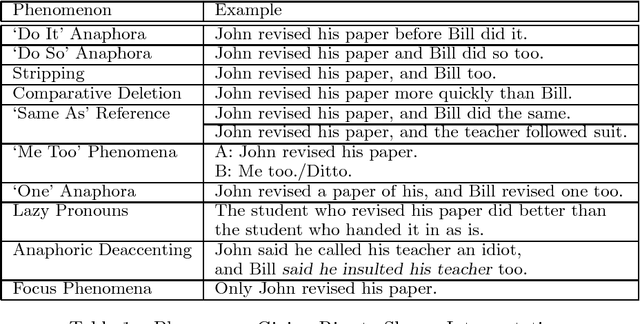Andrew Kehler
SRI International
Probabilistic Coreference in Information Extraction
Jun 10, 1997


Abstract:Certain applications require that the output of an information extraction system be probabilistic, so that a downstream system can reliably fuse the output with possibly contradictory information from other sources. In this paper we consider the problem of assigning a probability distribution to alternative sets of coreference relationships among entity descriptions. We present the results of initial experiments with several approaches to estimating such distributions in an application using SRI's FASTUS information extraction system.
* LaTeX, 11 pages, requires aclap.sty
A Theory of Parallelism and the Case of VP Ellipsis
Apr 29, 1997



Abstract:We provide a general account of parallelism in discourse, and apply it to the special case of resolving possible readings for instances of VP ellipsis. We show how several problematic examples are accounted for in a natural and straightforward fashion. The generality of the approach makes it directly applicable to a variety of other types of ellipsis and reference.
* LaTeX, 8 pages, requires aclap.sty
The Semantics of Resource Sharing in Lexical-Functional Grammar
Feb 13, 1995
Abstract:We argue that the resource sharing that is commonly manifest in semantic accounts of coordination is instead appropriately handled in terms of structure-sharing in LFG f-structures. We provide an extension to the previous account of LFG semantics (Dalrymple et al., 1993b) according to which dependencies between f-structures are viewed as resources; as a result a one-to-one correspondence between uses of f-structures and meanings is maintained. The resulting system is sufficiently restricted in cases where other approaches overgenerate; the very property of resource-sensitivity for which resource sharing appears to be problematic actually provides explanatory advantages over systems that more freely replicate resources during derivation.
* 8 pages, to appear in EACL-95. Requires eaclap.sty, tree-dvips.sty, tree-dvips.pro, lingmacros.sty, dgmacros.tex, lfgmacros.tex. Comments welcome.
Common Topics and Coherent Situations: Interpreting Ellipsis in the Context of Discourse Inference
May 03, 1994



Abstract:It is claimed that a variety of facts concerning ellipsis, event reference, and interclausal coherence can be explained by two features of the linguistic form in question: (1) whether the form leaves behind an empty constituent in the syntax, and (2) whether the form is anaphoric in the semantics. It is proposed that these features interact with one of two types of discourse inference, namely {\it Common Topic} inference and {\it Coherent Situation} inference. The differing ways in which these types of inference utilize syntactic and semantic representations predicts phenomena for which it is otherwise difficult to account.
* To be presented at ACL-94. 13 pages, LaTeX source, accompanying PostScript figures, requires psfig and lingmacros. Comments are welcome
Temporal Relations: Reference or Discourse Coherence?
May 02, 1994Abstract:The temporal relations that hold between events described by successive utterances are often left implicit or underspecified. We address the role of two phenomena with respect to the recovery of these relations: (1) the referential properties of tense, and (2) the role of temporal constraints imposed by coherence relations. We account for several facets of the identification of temporal relations through an integration of these.
* To appear in the Proceedings of ACL-94, Student Session. 5 pages, LaTeX source, requires lingmacros. Comments are welcome
 Add to Chrome
Add to Chrome Add to Firefox
Add to Firefox Add to Edge
Add to Edge